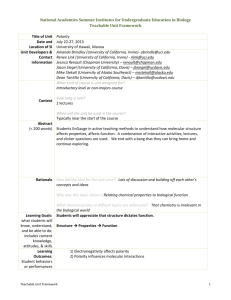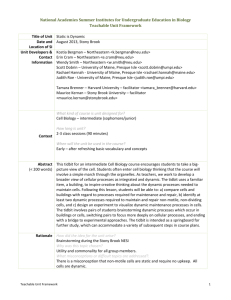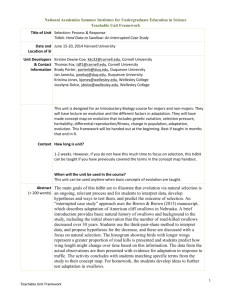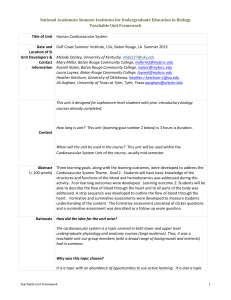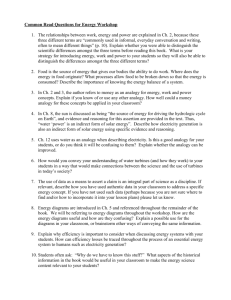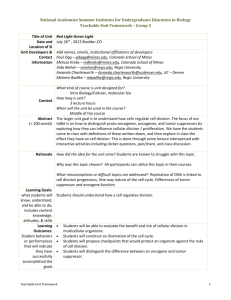Cellular Respiration (framework) Gulf Coast 2013
advertisement
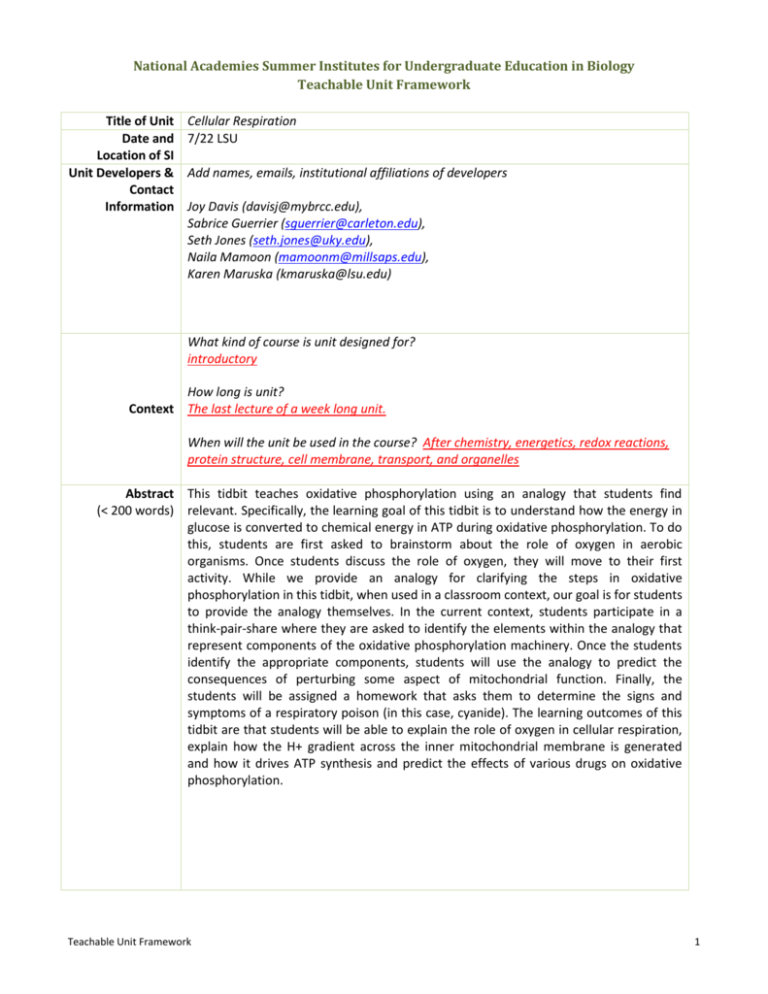
National Academies Summer Institutes for Undergraduate Education in Biology Teachable Unit Framework Title of Unit Date and Location of SI Unit Developers & Contact Information Cellular Respiration 7/22 LSU Add names, emails, institutional affiliations of developers Joy Davis (davisj@mybrcc.edu), Sabrice Guerrier (sguerrier@carleton.edu), Seth Jones (seth.jones@uky.edu), Naila Mamoon (mamoonm@millsaps.edu), Karen Maruska (kmaruska@lsu.edu) What kind of course is unit designed for? introductory How long is unit? Context The last lecture of a week long unit. When will the unit be used in the course? After chemistry, energetics, redox reactions, protein structure, cell membrane, transport, and organelles Abstract This tidbit teaches oxidative phosphorylation using an analogy that students find (< 200 words) relevant. Specifically, the learning goal of this tidbit is to understand how the energy in glucose is converted to chemical energy in ATP during oxidative phosphorylation. To do this, students are first asked to brainstorm about the role of oxygen in aerobic organisms. Once students discuss the role of oxygen, they will move to their first activity. While we provide an analogy for clarifying the steps in oxidative phosphorylation in this tidbit, when used in a classroom context, our goal is for students to provide the analogy themselves. In the current context, students participate in a think-pair-share where they are asked to identify the elements within the analogy that represent components of the oxidative phosphorylation machinery. Once the students identify the appropriate components, students will use the analogy to predict the consequences of perturbing some aspect of mitochondrial function. Finally, the students will be assigned a homework that asks them to determine the signs and symptoms of a respiratory poison (in this case, cyanide). The learning outcomes of this tidbit are that students will be able to explain the role of oxygen in cellular respiration, explain how the H+ gradient across the inner mitochondrial membrane is generated and how it drives ATP synthesis and predict the effects of various drugs on oxidative phosphorylation. Teachable Unit Framework 1 National Academies Summer Institutes for Undergraduate Education in Biology Teachable Unit Framework Rationale How did the idea for the unit arise? Brainstorming Why was this topic chosen? Most difficult topic for students to overcome Learning Goals: what students will know, understand, and be able to do; includes content knowledge, attitudes, & skills What misconceptions or difficult topics are addressed? Where does the energy come from (chemical bonds)? Have difficulty following the inputs and outputs at each stage of metabolism, the purpose of NADH and that energy comes from carbon oxidation. - Summarize the overall equation of respiration - Connect breathing and eating to energy - Understand that electrons possess chemical energy - Understand the role of ATP and NADH as energy carriers - To outline the stages of respiration. Their input and output and location of these processes - Contrast oxidative phosphorylation vs. substrate level phosphorylation - Understand that energy from electrons can be converted to kinetic energy to drive ATP production Learning Outcomes: Student behaviors or performances that will indicate they have successfully accomplished the goals List ATP number from each stage. Define cellular respiration. State summary reaction equation. Predict yields when specific steps in cellular respiration are impaired. Determine the effects of drug inhibitors on oxidative phosphorylation. Also determine the effects of lack of oxygen. Connect the mode of cellular respiration to a particular activity (i.e. exercise) Determine where ATP and NADH is generated. Determine where is CO2 formed. Determine where is O2 consumed. Explain how H+ gradients are created and how this gradient drives ATP synthase. Assess the advantage of compartmentalization of respiration. Incorporation of Scientific Teaching Themes Active Learning Teachable Unit Framework Assessment Diversity 2 National Academies Summer Institutes for Undergraduate Education in Biology Teachable Unit Framework How students will engage actively in learning the concepts 1. Students are first asked to brainstorm regarding the importance of oxygen for breathing. How teachers will measure learning; how students will selfevaluate learning Students will be evaluated by their ability to create the appropriate analogy. Discussion will be used to address any misconceptions. How the unit is designed to include participants with a variety of experiences, abilities, and characteristics Uses diverse active learning techniques 2. Students participate in a thinkpair-share where they are asked to identify the elements within the analogy that represent components of the oxidative phosphorylation machinery. Alternatively, students participate in a think-pair-share where they will create an analogy for oxidative phosphorylation. The analogies will be presented to the class and the most appropriate analogy will then be used in the next exercise. 3. Clicker Questions: Students will use the analogy to predict the consequence of perturbing some aspect of the analogy on mitochondrial function 4. The students will be assigned a homework assignment that asks them to determine the signs and symptoms of a respiratory poison (in this case, cyanide). Teachable Unit Framework 3 National Academies Summer Institutes for Undergraduate Education in Biology Teachable Unit Framework Activities outside of class: Pre-assessments: Students will be assigned a homework assignment that asks them to determine the signs and symptoms of a respiratory poison (in this case, cyanide). Brainstorming about the role of oxygen in cellular respiration. Post-tidbit assessments: Activities in class: Students are first asked to brainstorm regarding the importance of oxygen for breathing. Students will be assigned a homework assignment that asks them to determine the signs and symptoms of a respiratory poison (in this case, cyanide). Students participate in a thinkpair-share where they are asked to identify the elements within the analogy that represent components of the oxidative phosphorylation machinery. Alternatively, students participate in a think-pair-share where they will create an analogy for oxidative phosphorylation. The analogies will be presented to the class and the most appropriate analogy will then be used in the next exercise. Students will use the analogy to predict the consequence of perturbing some aspect of the analogy on mitochondrial function Teachable Unit Framework 4 National Academies Summer Institutes for Undergraduate Education in Biology Teachable Unit Framework Activities during tidbit: See activities in class Sample Presentation Plan (general schedule with approximate timing for unit) Session 1 Time (min) Learning Outcome(s) Activity/assessment Explanation, notes, suggestions, tips Preclass n/a Enter approx. class time for learning activity preparatory material presentation 5 min Teachable Unit Framework 5 National Academies Summer Institutes for Undergraduate Education in Biology Teachable Unit Framework Enter approx. class time for learning activity #1 5 minutes for activity 1, 10 minutes for activity 2 and 5 minutes for activity 3 Enter approximate time for additional learning activities and associated class Work/preparatory materials 5 minutes Enter approximate time for post-activity summing up or transition 2 minutes Add additional activities information as needed for the unit. Resources for Teaching the Unit -ppt -worksheet/analogy Effectiveness of unit (if you have used it in your own teaching) Students seem to enjoy it. Teachable Unit Framework 6 National Academies Summer Institutes for Undergraduate Education in Biology Teachable Unit Framework Acknowledgements (Facilitators, others who gave input, information, etc.) Peter Cavnar, Chris Gregg, Bill Wischusen, Joe Siebenaller, GCSI participants, organizers, and support staff. Teachable Unit Framework 7
